A look at Windows 8 Tablets running on TI, Qualcomm, Nvidia, AMD and Intel silicon
by Brian Klug on September 14, 2011 9:00 PM ESTThis afternoon (and yesterday) we had a chance to meet with a number of SoC vendors who have partnered with Microsoft for Windows 8. Each of them has their own individual reference tablet running Windows 8, and today we had a chance to survey the landscape and get photos of all the tablets. We started with ARM, then looked at x86 based tablets. Of course, the real goal with Windows 8 is to abstract as much of the difference between these two platforms away.
Unfortunately, all of the ARM vendors were required to keep their tablets under glass and out of the way of physical contact per Microsoft instruction. Microsoft isn't ready to show off the ARM version of Windows 8 for a variety of reasons at this point (at least without a Microsoft rep. present), but we still got a chance to at least take a look at what there is now. Microsoft is encouraging tablet makers to target either a 10.1" or 11.6" form factor with 1366x768 resolution (ed: Metro will require 1024x768 as a minimum, so 1280x720 displays don't meet Microsoft's requirements).
Texas Instruments
First up is TI, whose development platform was demoed playing back the 1080p30 H.264 baseline video shown in the keynote fluidly in windows media player with a split-screen view. One tablet displayed the start menu, another displayed two split screen games. TI's development platform as shown right now is running on OMAP 4430, which again consists of two ARM Cortex A9s at 1.0 GHz and PowerVR SGX 540 graphics. Windows 8 won't launch on OMAP 4430, however, instead it'll launch on the more powerful OMAP 4470 platform with PowerVR SGX544 graphics and a 2D display compositor. The reason is partly due to SGX544 having full Direct3D 9.3 compliance, partly because it's an all around faster platform. I'm told that right now there's some Direct3D emulation going on as well for all the SoCs that don't support Direct3D 9.3.
I also recorded a short video showing the TI Windows 8 tablet in action.
Qualcomm
My next stop was Qualcomm, whose current development tablet runs on an MSM8660 SoC, which consists of two scorpion cores and Adreno 220 graphics. Qualcomm took the tablet out of the glass box for us and showed a quick demonstration of the start menu scrolling back and forth, and the IE10 mobile view working and scrolling around.
Unfortunately we weren't allowed to shoot video of the tablet while that demo was running, but we did grab some photos of the tablet without the glass box. Performance on the start menu looked to be above 30fps the whole time but not buttery smooth like the x86 tablets we've seen so far.
Just like TI, Qualcomm won't go to market with the SoC they're demonstrating Windows 8 working on today, instead they'll use the more powerful dual core Krait MSM8960 at first and quad core Krait APQ8064 later on. Dual core krait SoCs (eg 8960, 8270, 8260A) come with Adreno 225, quad core krait (APQ8064 and others) come with Adreno 320, both of which are Direct3D 9.3.
NVIDIA
We've seen NVIDIA's Kal-El quad-core A9 based tablet a few times now, and found it out on the floor, also behind glass. Unlike the other vendors, NVIDIA hasn't said anything about going to market for Windows 8 with anything but Kal-El, and I don't see any reason why they should either.
The Kal-El development tablet was seated in a nice looking dock with what looks like one USB 3.0 port and a full size HDMI port.
AMD
Switching over to the x86 camp, we have AMD, who showed us two tablets running on Brazos - the Acer Iconia Tab W500 and MSI WindPad 110W, which use a C-50 and Z-01 APU, respectively. Displays on these are 1280x800 and support capacitive touch just like you'd expect for Windows 8.
Both the MSI WindPad and Iconia Tab felt snappy and responsive running the same Windows 8 Developer Preview build that we've used on the Samsung developer hardware. Subjectively, the WindPad's capacitive panel was more responsive and less prone to errant touch recognition than the Iconia, though both were more than useable with Windows 8.
Intel
Last but not least is Intel's own development tablet, which is running an unnamed 32nm SoC. Intel was suspiciously silent about which particular SoC was inside this device, and you'll notice that it too is locked down in a plastic box, lumping it squarely in the next-gen SoC category for Microsoft.
It's possible this is Medfield, it's also possible this is some 2nd gen 32nm Atom SoC. Hopefully we'll find out more as Windows 8 starts getting closer to launch.


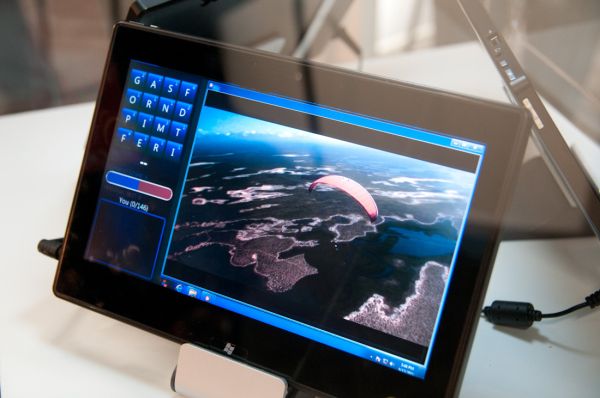
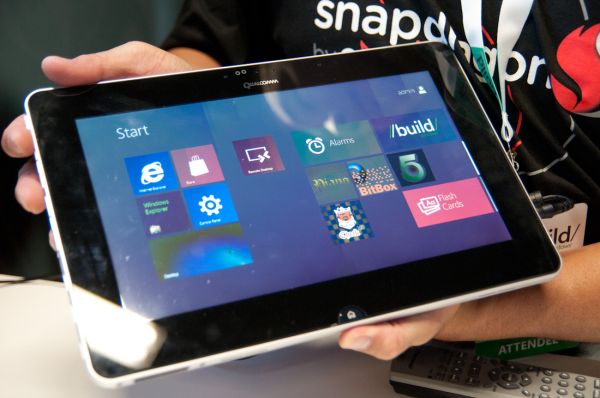
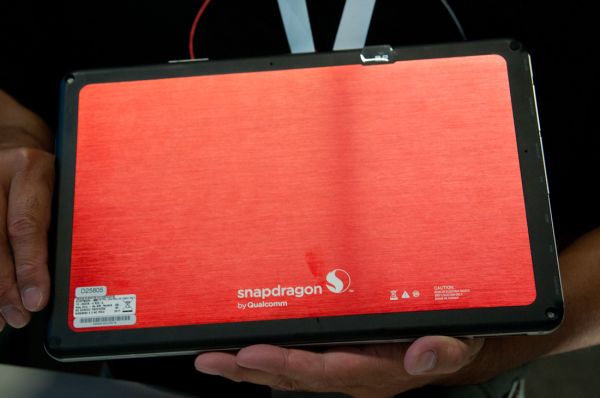
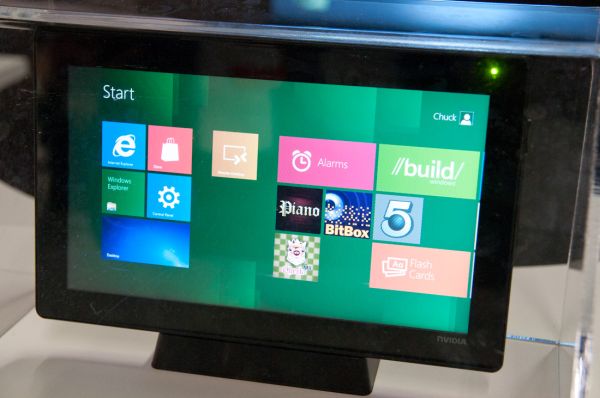
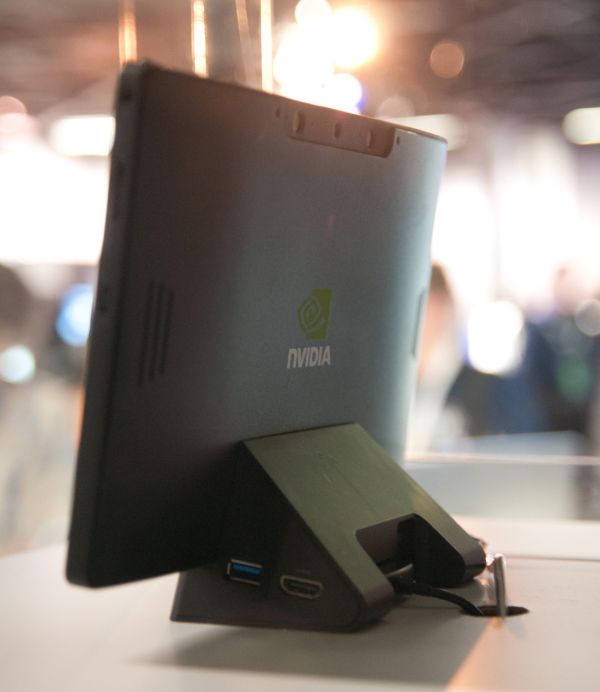
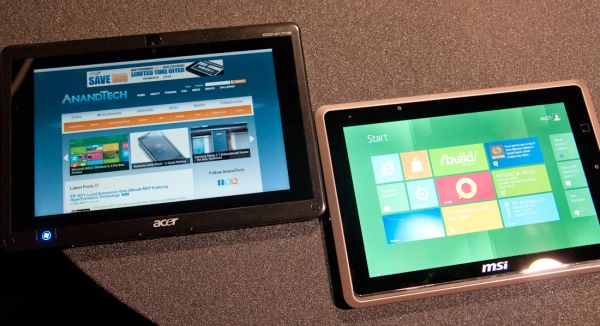
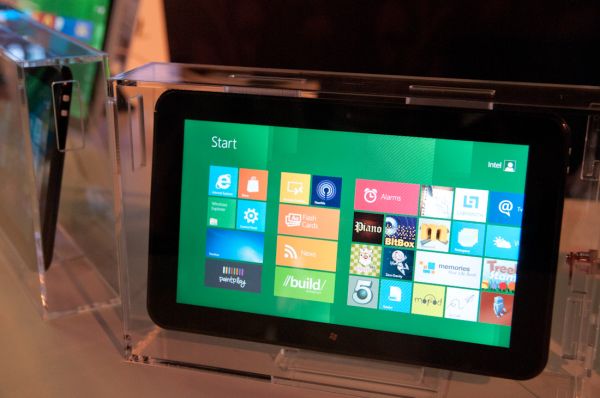














92 Comments
View All Comments
Dug - Friday, September 16, 2011 - link
The Asus EP121 sold like hotcakes. It was order and wait because they didn't realize the demand.Really incredible machine and a great example of what can be done on that form factor.
mados123 - Sunday, September 18, 2011 - link
Your sense of "meaningful sales" is compared to the iPad. A $1,000 tablet obviously will not have comparable sales and it is directed towards the niche market. If you don't a unique need for that type of machine (which was ahead of it's time, hardware wise) then the majority of the public won't be buying in.As the hardware gets faster, lighter and less expensive, I want an OS that is ready and can do everything I want it to do with my setup - not an OS and company that tells me what I can do with their setup.
damianrobertjones - Thursday, September 15, 2011 - link
P.s. "nobody wants to trust windows with ANYTHING."What planet are you on? I'm not even going to say anything else about that statement above
Lord Moldy butt - Thursday, September 15, 2011 - link
Execution of what? a still immature operating system? Theres a reason why Windows is STILL the desktop leader and why it is positioning it'snext OS to become the leader of the tablet interface. One OS that will
be on three diferrent platforms.
joelypolly - Wednesday, September 14, 2011 - link
Except what you are saying has already been tried many times by Microsoft. Remember TabletPCs? They ran Windows + PROGRAMS as you said and they failed and they will continue to fail unless there are touch based apps that make sense.damianrobertjones - Thursday, September 15, 2011 - link
They failed due to a few things- price
- Public awareness
I've owned a whole load of tabs over the years so I was there and know the history (In the UK).
The oems were also lazy .
Owned: HP TC1100, Toshiba M400, Toshiba M750, HP TC4200, HP TC4400, Fujitsu Tab, Latitude XT & XT2, Acer 1820ptz, Archos 9, Samsung Q1 ultra, Sony VGN-UX1XN, Viewsonic Viewpad 10, Asus R2h, HP 2740p, HP TM2-1050ea, Asus EP121, another HP TM2-2050ea, two Acer W500
B3an - Thursday, September 15, 2011 - link
The pre-beta of Win 8 released yesterday is for this. So developers can make Win 8 touch apps for the new Win 8 store a full year ahead of release. There will be LOADS of apps by then. This is Windows, not some random new OS no ones heard of that may or may not do well.Exodite - Thursday, September 15, 2011 - link
The need for backwards compatibility on a touch-based tablet device is rather minimal, especially once you consider that developers will have to adopt new development tools to produce native metro applications and then recompile to allow those to run on ARM as well.B3an - Thursday, September 15, 2011 - link
No. Devs dont have to do learn anything new. They can use pretty much any current Windows programming language to make Metro apps. And use the usual Visual Studio to do it. At the Build conference yesterday MS showed an app converted to metro in a matter of minutes, it was all done live.It's NOTHING like other tablet platforms where you have to learn a whole ton of new stuff. Making Metro apps is stupid easy, you can even use HTML5/JS to do it and it will automatically be hardware accelerated.
kmmatney - Thursday, September 15, 2011 - link
My guess is that not all programs will work - at least I don't think 3DStudioMax would work on an ARM processor. Running x86 programs on an ARM will probably require some sort of emulation layer, which will slow things down.